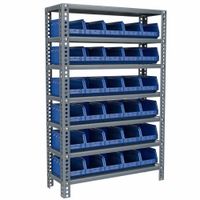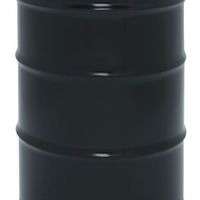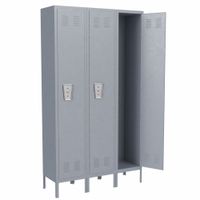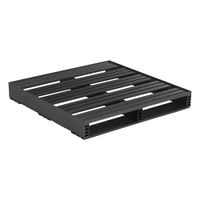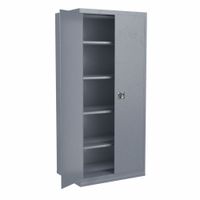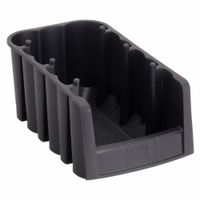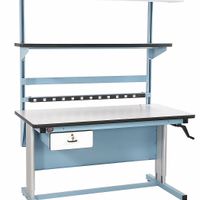Call +(254) 703 030 000 / 751 483 999 / 721 704 777
- Home
- Material Handling
- Storage Workspace
.....Read More
Frequently Asked Questions
What are the best storage solutions for small spaces?
When dealing with small spaces, optimizing storage is crucial. Consider multi-functional furniture, such as ottoman with hidden storage, a bed with built-in drawers, or a coffee table that lifts to reveal storage. Vertical space is your friend; utilize wall-mounted shelving, tall bookcases, and hanging organizers. Under-bed storage containers are excellent for seasonal items or extra linens. Over-the-door hooks and racks can add significant storage to closets and bathrooms. For kitchens, pantry organizers, stackable containers, and drawer dividers can maximize cabinet space. Think about slim-profile furniture that doesn't overwhelm the room. Finally, declutter regularly to ensure you're only storing what you truly need.
How do I choose the right shelving for my garage?
Choosing the right shelving for your garage involves considering several factors to ensure it meets your storage needs and space constraints. First, assess the type and weight of items you plan to store. Heavy-duty shelving made from steel or reinforced plastic is ideal for tools, automotive parts, and bulk supplies, while lighter-duty options are suitable for smaller items like gardening supplies or holiday decorations.
Next, measure your available garage space, including height, width, and depth. This will help you determine the maximum size of shelving units that will fit without obstructing walkways or vehicles. Consider vertical space, as tall shelving can maximize storage in a small footprint.
Think about the material of the shelving. Steel is durable and can hold significant weight, but it can be more expensive. Plastic shelving is lighter, often more affordable, and resistant to rust and mildew, making it good for damp environments. Wood shelving can be customized but may require more maintenance.
Consider the shelving style: * **Freestanding units** are versatile and can be moved.
* **Wall-mounted shelving** saves floor space and is excellent for heavy loads when properly installed.
* **Overhead shelving** utilizes ceiling space, perfect for seasonal items or things you don't access frequently.Finally, set a budget and research different brands and options. Reading reviews can provide insights into durability and ease of assembly. By carefully considering these points, you can select garage shelving that is both functional and efficient.
What are the benefits of using storage racks over cabinets?
Storage racks offer several advantages over cabinets, particularly in commercial or industrial settings. They provide better visibility and accessibility to stored items, making inventory management and retrieval more efficient. Their open design allows for better air circulation, which can be beneficial for certain types of goods. Racks are also generally more versatile and easier to reconfigure or expand as storage needs change, whereas cabinets are typically fixed in size and design. Additionally, racks often have a higher weight capacity, making them suitable for heavy or bulky items that might overwhelm standard cabinets.
How can I maximize storage in my workspace?
To maximize storage in your workspace, consider a multi-faceted approach. First, declutter regularly by removing unnecessary items, digital files, and old documents. Utilize vertical space with shelves, wall-mounted organizers, and stackable bins. Under-desk drawers, monitor stands with storage, and mobile pedestals can help optimize hidden spaces. For digital storage, leverage cloud services, external hard drives, and regularly clean up your computer's downloads and desktop. Implement a consistent filing system for both physical and digital items, labeling clearly to ensure easy retrieval. Finally, invest in multi-functional furniture, such as an ottoman with storage or a desk with built-in shelving, to make the most of every square foot.
What materials are best for durable storage cabinets?
For durable storage cabinets, several materials stand out, each with its own advantages. Steel is a top choice, known for its exceptional strength, resistance to dents, and ability to withstand heavy loads. It's often used in industrial or garage settings due to its ruggedness and ease of cleaning. Stainless steel offers similar durability with added resistance to corrosion and rust, making it suitable for environments with high humidity or chemical exposure.
Solid wood, particularly hardwoods like oak, maple, or birch, offers excellent strength and a classic aesthetic. While more susceptible to scratches and moisture damage than metal, treated and well-maintained solid wood cabinets can last for decades. Plywood, especially Baltic birch or marine-grade plywood, is a strong and stable engineered wood product that resists warping and shrinking better than solid wood. It's often used for cabinet boxes, offering good screw retention and load-bearing capacity.
Particleboard or MDF (Medium-Density Fiberboard) are more economical options, but their durability varies greatly with density and quality. High-density versions can be quite strong, but they are more susceptible to moisture damage and often require a protective laminate or veneer. For general storage in low-moisture environments, high-quality particleboard or MDF can be a viable option, but for heavy-duty or long-term durability, steel, solid wood, or plywood are superior choices.
How do I organize tools and small parts efficiently?
Efficiently organizing tools and small parts is crucial for productivity and preventing loss. Start by decluttering and discarding any broken or unused items. Categorize remaining items by type, frequency of use, and size.
For tools, consider a pegboard system for wall-mounted items, allowing for easy visibility and access. Toolboxes with multiple compartments, rolling carts, or dedicated tool chests are excellent for storage, especially for larger or more frequently used items. Labeling drawers or sections within toolboxes helps in quick retrieval.
For small parts like screws, nails, washers, or electronic components, clear, stackable bins or organizers with adjustable dividers are ideal. These allow you to see the contents at a glance and prevent mixing. Wall-mounted storage bins, carousel organizers, or tackle boxes are also effective. Label each compartment clearly to avoid confusion.
Consider shadow boards for frequently used tools, outlining where each tool belongs. This makes it immediately apparent if a tool is missing. Magnetic strips can hold metal tools or small parts securely.
Ultimately, the best system depends on the volume and variety of your items, as well as your workspace. Regular maintenance and a "place for everything, and everything in its place" mentality will ensure long-term efficiency.
What are the security features of modern lockers?
Modern lockers have evolved significantly to offer enhanced security features. Keyless entry systems are increasingly common, utilizing technologies such as RFID cards, PIN codes, or biometric scans (fingerprint or facial recognition) to restrict access to authorized users. These systems often integrate with software platforms that allow for centralized management, auditing of locker usage, and real-time alerts in case of tampering or unauthorized access.
Material advancements also contribute to security, with lockers being constructed from more durable and resistant materials like reinforced steel or composite alloys. Anti-pry designs, concealed hinges, and multi-point locking mechanisms further deter forced entry. Some advanced lockers include internal cameras or sensors to detect motion or temperature changes, providing an additional layer of monitoring. Networked lockers can even be remotely locked, unlocked, or monitored, offering flexibility and control, especially in large-scale installations or smart building environments. These combined features provide a robust and adaptable security solution for various applications, from personal storage to secure asset management.
How do I maintain and clean storage containers?
To maintain and clean storage containers effectively, start by emptying them and rinsing off any loose debris. For everyday cleaning, wash with warm, soapy water and a soft sponge. For tougher stains or odors, create a paste with baking soda and a little water, apply it to the affected area, let it sit for 15-30 minutes, then scrub and rinse thoroughly. Vinegar can also be used as a natural disinfectant and deodorizer; dilute it with water and wipe down the containers. Ensure containers are completely dry before storing to prevent mildew and mold growth. For airtight seals, regularly check gaskets and lids for cracks or wear, replacing them if necessary to maintain freshness. Avoid abrasive cleaners or scouring pads, as these can scratch the plastic and harbor bacteria. Regular cleaning and proper drying will extend the life of your containers and keep your stored items fresh.
What are the best practices for storing hazardous materials?
Storing hazardous materials safely and effectively requires adherence to strict best practices to protect personnel, the environment, and property. Key principles include proper labeling and signage, ensuring all containers are clearly marked with their contents, hazard warnings, and appropriate safety precautions. Compatibility is crucial; incompatible materials must be stored separately to prevent dangerous reactions. This often involves segregation by hazard class (e.g., flammables, corrosives, oxidizers).
Storage areas should be secure, well-ventilated, and temperature-controlled to prevent material degradation or increased volatility. Shelving and containment systems must be sturdy, corrosion-resistant, and capable of holding spills. Secondary containment, such as spill pallets or berms, is essential to capture leaks or ruptures. Regular inspections of storage areas and containers are necessary to identify damage, leaks, or expired materials.
Personnel handling hazardous materials must receive comprehensive training on safe handling procedures, emergency response, and the use of personal protective equipment (PPE). A clear emergency plan, including spill response protocols and first aid, should be in place and regularly practiced. Finally, maintaining accurate inventory records helps track materials, manage quantities, and ensure proper disposal when necessary. Adhering to these practices minimizes risks and promotes a safe working environment.
How do I select the right workbench for my needs?
Selecting the right workbench involves considering several factors to ensure it meets your specific needs. First, assess the type of work you'll be doing. Light-duty tasks like crafting or electronics might require a smaller, less robust bench, while heavy-duty projects like woodworking or metalworking demand a sturdy, durable surface.
Next, consider the available space in your workshop or garage. Measure the area and choose a workbench that fits comfortably without obstructing movement or other equipment. Think about whether you need a mobile workbench for flexibility or a stationary one for stability.
The material of the workbench top is crucial. Common options include solid wood (like maple or beech) for durability and shock absorption, MDF for affordability and smoothness, or steel for heavy-duty industrial use. Each material has its pros and cons regarding cost, maintenance, and suitability for different tasks.
Storage is another important aspect. Determine if you need built-in drawers, shelves, or pegboards to keep tools organized and within reach. Some workbenches also come with integrated power strips or vices, which can enhance functionality.
Finally, consider your budget. Workbenches vary widely in price, so set a realistic budget and prioritize features that are essential for your work. Reading reviews and comparing different models can help you find the best value for your investment.
